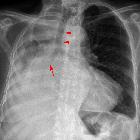large-cell lymphoma of the mediastium

Primary mediastinal large B-cell lymphoma is a distinct entity, recognized in the WHO classification of lymphoma.
Epidemiology
Primary mediastinal large B-cell lymphoma accounts approximately 5% of large B-cell lymphoma, which is usually disseminated or found in the abdomen. There appears to be a younger age of diagnosis (30s) and female predilection (F:M 3:2), when compared to other large-cell lymphomas, which usually present in the 50s and have a male predilection (M:F 2:1) .
Unfortunately, from an imaging point of view, these demographics are similar to those of nodular sclerosing Hodgkin lymphoma, which is a common cause of a primarily mediastinal lymphoma .
Clinical presentation
Clinical presentation is usually due to the mass effect of the typically large anterior mediastinal mass. SVC compression resulting in SVC syndrome is relatively common, present in up to 35% of cases .
Pathology
Primary mediastinal large B-cell lymphoma is a distinct type of B-cell lymphoma and is thought to arise from thymic B-cells .
Radiographic features
The vast majority of patients have an anterior mediastinal mass. Middle and posterior mediastinal involvement, either in isolation or contiguously with the anterior mediastinal component are uncommon .
Plain radiograph
Chest radiography demonstrates a soft tissue anterior mediastinal mass.
CT
CT of the chest usually shows:
- soft-tissue attenuating mass
- usually large at diagnosis ~10 cm diameter
- mass effect common
- bowing and compression of the trachea
- SVC obstruction: up to 35% cases
- cystic areas are common: up to 44%
- calcification pre-treatment is uncommon but recognized
- chest wall invasion may occur
- pleural effusion(s)/pericardial effusion
- seen in up to a third of cases
- pleural effusion may be associated with poor outcome
Treatment and prognosis
Mediastinal large B-cell lymphoma tends to have a more aggressive behavior and poorer response to treatment than other large-cell lymphomas, although the overall response to chemotherapy and/or radiotherapy is still good .
Poor prognostic indicators are :
- advanced stage at diagnosis
- direct involvement of thoracic viscera
- infra-diaphragmatic spread
- pleural effusion
Complications
- SVC syndrome
- respiratory compromise due to
- tracheal compression
- pleural effusions
Differential diagnosis
The differential diagnosis on chest x-ray is relatively broad, including most causes of an anterior mediastinal mass.
On CT, the differential is narrower:
- other types of lymphoma
- when isolated to mediastinum features are essentially indistinguishable
- most common lymphoma types to be considered are
- nodular sclerosing Hodgkin lymphoma
- lymphoblastic lymphoma
- thymic tumors
- mediastinal germ cell tumors
- nodal metastases from bronchogenic carcinoma: isolated anterior mediastinal involvement is rare
Siehe auch:

 Assoziationen und Differentialdiagnosen zu primary mediastinal large B-cell lymphoma:
Assoziationen und Differentialdiagnosen zu primary mediastinal large B-cell lymphoma:





